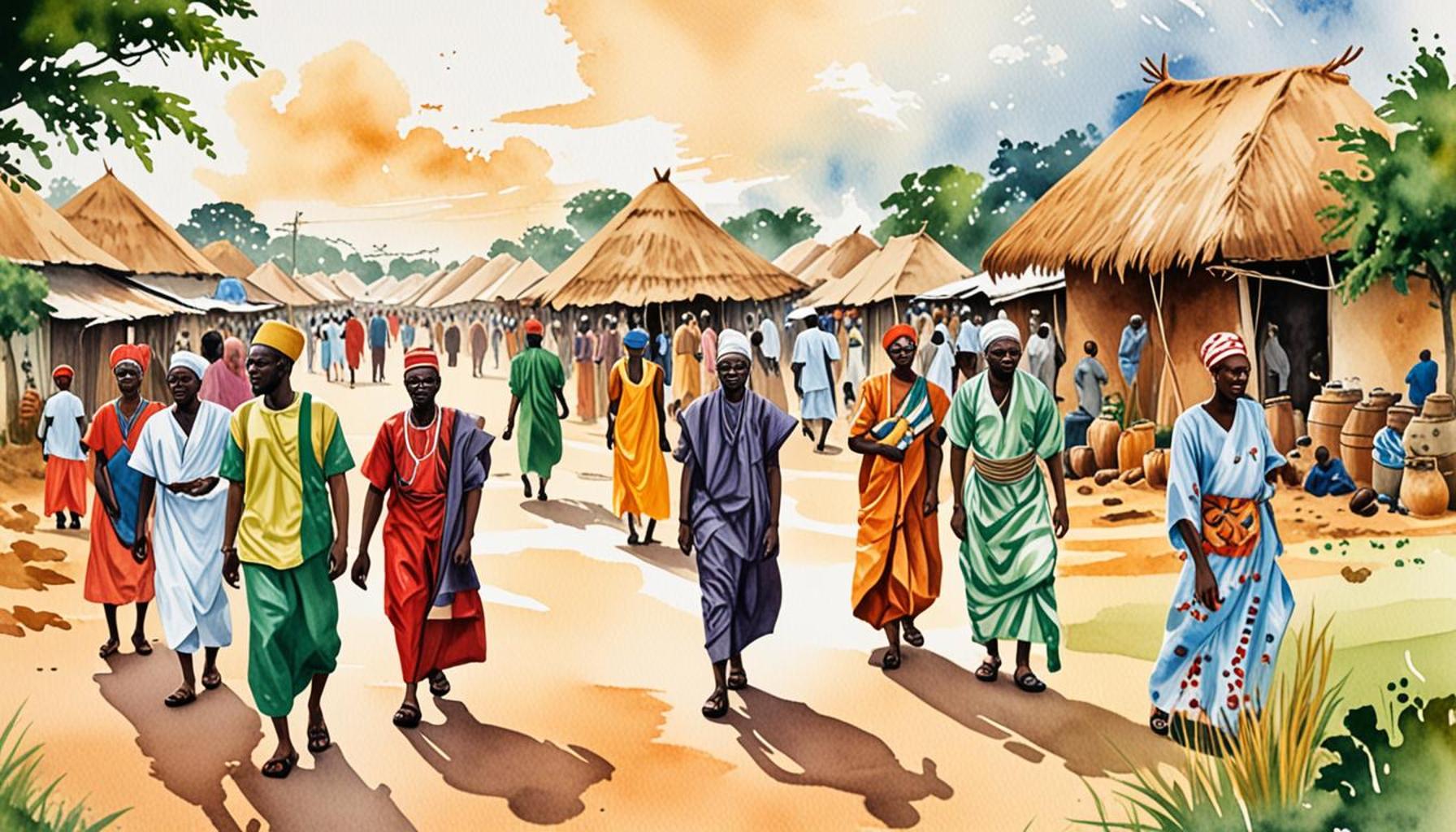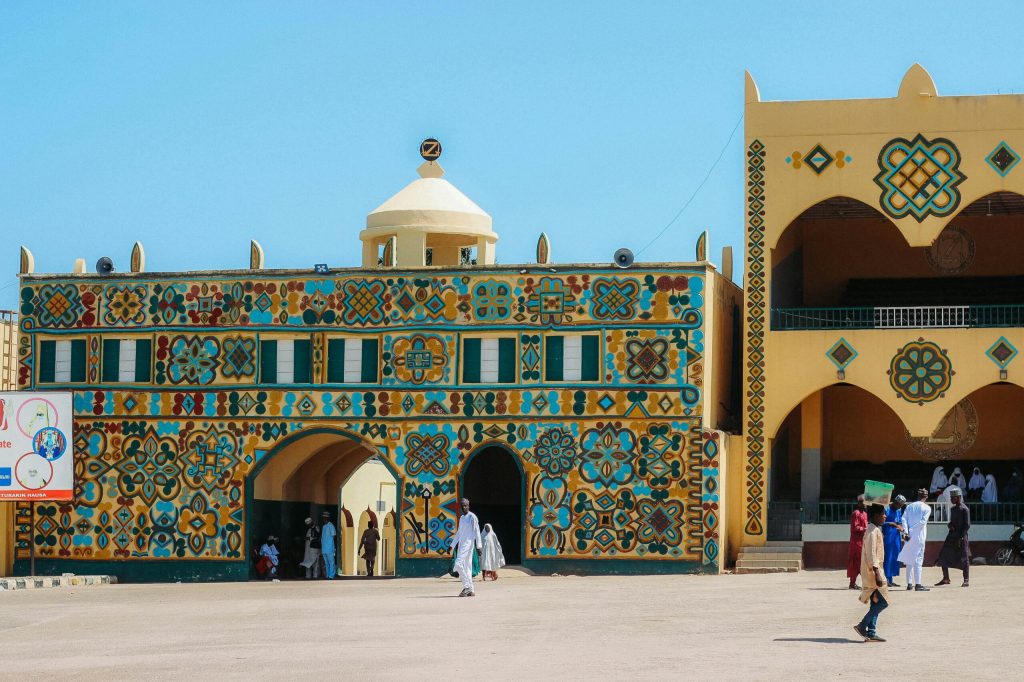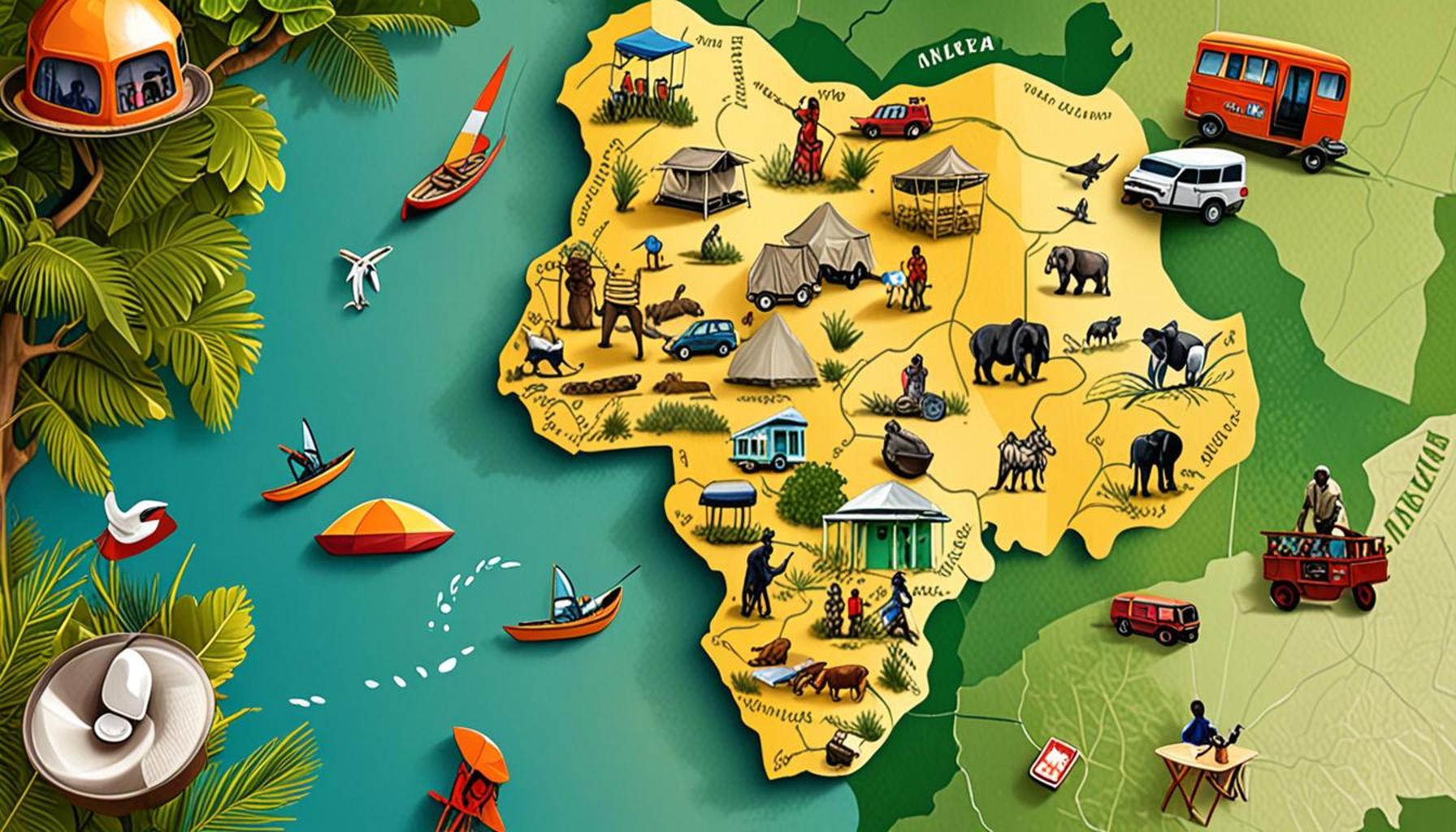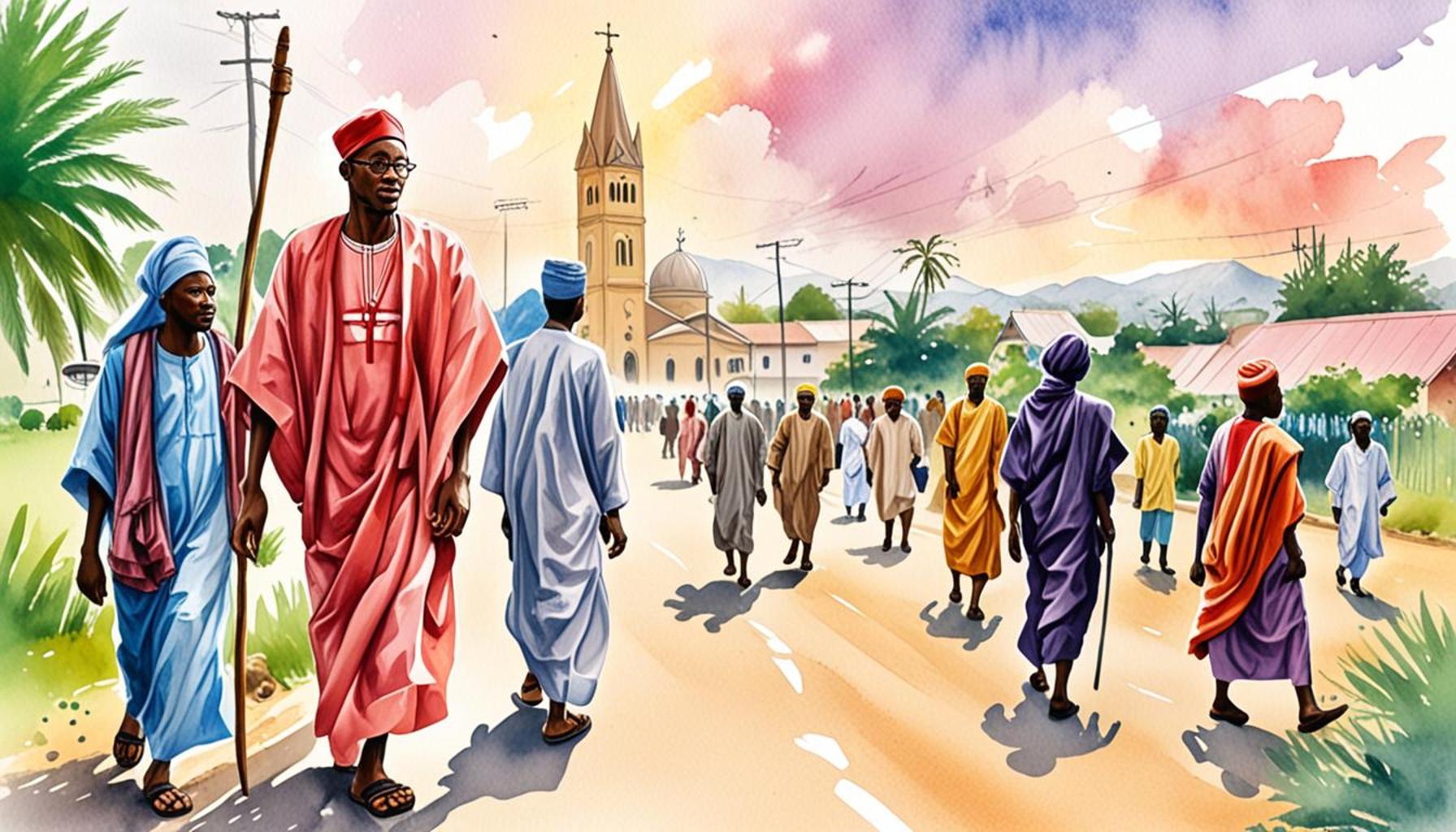Explore Nigerias Cultural Routes A Journey Through History Tradition

Embarking on a journey through Nigeria’s cultural routes offers travelers a unique glimpse into the rich tapestry of history and tradition that defines this vibrant nation. With a blend of ethnic groups, languages, and customs, Nigeria stands as a testament to the depth of African heritage. Exploring these routes is not just about sightseeing; it’s about immersing oneself in the stories, rituals, and art forms that have shaped the identity of its people.
As one of Africa’s most populous countries, Nigeria boasts a multitude of attractions that enhance its tourist itineraries, including:
- Historic sites that echo the past, revealing the legacies of ancient civilizations.
- Festivals that showcase traditional music, dance, and culinary delights.
- Art galleries and markets where local artisans celebrate Nigeria’s diverse artistic expressions.
This article will guide you through the Top 5 cultural routes in Nigeria, each representing a different facet of the nation’s tradition. Whether you’re a history buff, a culture enthusiast, or simply seeking an unforgettable travel experience, these routes promise to enrich your understanding of Nigeria’s multifaceted heritage.
Exploring Nigeria’s Cultural Routes: A Journey Through History and Tradition
Nigeria, often termed as the “Giant of Africa,” is a nation renowned for its vibrant tapestry of cultures, astounding traditions, and a history that is as diverse as its people. Exploring Nigeria’s cultural paths offers an unrivaled opportunity to delve into rich narratives and vibrant experiences that reflect the country’s complexity and depth. This article presents a carefully curated list of the top five destinations for immersing oneself in Nigeria’s extensive cultural landscape. Prepare for an unforgettable journey of discovery and enlightenment!
5. The National Museum, Lagos
The National Museum in Lagos stands as a guardian of Nigeria’s rich 20th-century cultural heritage, offering an intriguing dive into the past. Founded in 1957, this museum is a treasure trove that houses a comprehensive collection of artifacts that chronicle the dynamic history of Nigeria. Most noteworthy among its exhibits are the Benin Bronzes, a stunning collection of plaques and sculptures originating from the 16th-century Benin Kingdom.

The museum enthralls visitors with its assortment of ancient carvings, masks, and pottery, each piece telling a story of Nigeria’s multifaceted cultural heritage. Artifacts such as Nok terracotta sculptures provide insight into civilizations that predate written history in the region. Furthermore, the museum often features exhibitions that spotlight contemporary Nigerian art, providing a dialogue between Nigeria’s storied past and its vibrant present.
Visitors are encouraged to spend time in the gift shop, where they can purchase unique crafts and artworks created by local artisans. These mementos allow travelers to carry a piece of Nigeria’s heart back home with them.
4. Aso Rock and the Nigerian Presidential Complex, Abuja
Aso Rock, located in Abuja, Nigeria’s capital, is a staggering 400-meter monolith that serves as a backdrop to the Nigerian Presidential Complex. Apart from its breathtaking stature, Aso Rock holds profound symbolic significance in Nigeria’s political history. This geological formation is deeply intertwined with the nation’s governance, hosting several key government buildings.
While visiting Abuja, take the opportunity to explore the striking architecture and rich history of the Nigerian National Mosque and the uniquely built Nigerian National Christian Centre. Both structures reflect Nigeria’s diverse religious landscape, offering insights into the country’s harmonious coexistence of different faiths.
Many tours provide visitors with an inside look at Nigeria’s political framework and the workings of its government. For those keen to understand the political intricacies of Nigeria, Aso Rock presents an indispensable stop.
3. The Osun-Osogbo Sacred Grove, Osogbo
Designated a UNESCO World Heritage Site, the Osun-Osogbo Sacred Grove is revered as a spiritual hub for the Yoruba people. This serene forest provides a sacred ground where nature, art, and spirituality merge to create a haven for pilgrims and tourists alike.
Every year, the grove becomes the focal point of the Osun-Osogbo Festival, a vibrant celebration that honors the river goddess Osun. This festival features a rich array of cultural displays, age-old rites, and infectious traditional music, making it a magnet for those seeking to experience Yoruba culture in its most authentic form.
The grove itself is home to numerous shrines, sculptures, and artworks that provide insights into the Yoruba’s spiritual practices and beliefs. The accompanying McGregor Museum within the grove helps deepen visitors’ understanding through its engaging exhibits that highlight local history. It’s a must-visit location for those desiring to connect with the spiritual and cultural heart of the Yoruba people.
2. Old Oyo National Park, Oyo State
Encompassing a stunning blend of natural beauty, Old Oyo National Park offers a journey through remnants of the ancient Oyo Empire, once a powerful kingdom. The park is an important cultural landmark that holds archeological sites and relics of past civilizations, revealing stories of a once-glorious empire.
Nature enthusiasts and history buffs will relish hikes that lead them to significant sites like the J Yoruba ancient city walls and the historic capital Oyo-Ile. Such treks are often enhanced by local guides who share captivating stories about the heritage of the Oyo Empire, creating an enriching educational experience.
The park’s stunning biodiversity also offers a chance to encounter Nigeria’s diverse wildlife, making it a dual experience of cultural exploration and natural wonder.
1. The Calabar Carnival, Calabar
Topping the list is the electrifying Calabar Carnival, affectionately dubbed as “Africa’s Biggest Street Party.” Taking place throughout December, this month-long celebration is a vibrant showcase of Nigerian culture through astounding music, rhythmic dance, mesmerizing art, and irresistible culinary treats. The carnival fosters a cultural melting pot that draws participants internationally, making it an epicenter of cultural exchange.
Each year, the carnival features exuberant parades, lively pageants, and performances that vividly reflect Nigeria’s rich and multifarious cultural heritage. Touted not just as an event but as a holistic experience, the carnival gives participants a chance to deeply connect with the pulse and spirit of the Nigerian people.
Innovative costumes and captivating displays weave narratives drawn from Nigeria’s extensive cultural fabric, ensuring that each visitor leaves with memories that last a lifetime.
In conclusion, Nigeria’s cultural routes promise incredible experiences steeped in rich tradition and history. From awe-inspiring museums and sacred groves to exuberant carnivals and aged imperial parks, each destination invites travelers to unveil the profound narratives of this diverse nation. Don’t hold back—prepare for an adventure that will undoubtedly broaden your understanding and appreciation of Nigeria’s dazzling cultural tapestry!
| Cultural Heritage | Impact on Society |
|---|---|
| Rich Traditional Arts | Art forms such as mask-making, beadwork, and pottery serve as a medium for storytelling and community identity. |
| Vibrant Festivals | These events, like the Osun-Osogbo Festival, promote cultural pride and offer a platform for showcasing traditional values. |
| Historical Landmarks | Sites such as the Old Oyo National Park and the Aso Rock allow visitors to connect with Nigeria’s deep-rooted history. |
| Gastronomic Diversity | Traditional dishes like jollof rice and egusi soup highlight regional flavors and culinary techniques, fostering a sense of belonging and community sharing. |
Exploring Nigeria’s cultural routes is more than just a journey through picturesque landscapes; it is an immersion into a rich tapestry of traditions that define the nation’s identity. For instance, the myriad of vibrant festivals celebrated across the country invites both locals and travelers to witness extraordinary displays of music, dance, and traditional attire. The Osun-Osogbo Festival, dedicated to the goddess Osun, not only celebrates spirituality but also emphasizes the preservation of cultural heritage, as participants partake in ancient rituals that have been passed down through generations.Moreover, Nigeria’s artistic expression manifests in its traditional crafts, revealing the historical narratives of its diverse ethnic groups. The artistry in mask-making is particularly significant, as these masks are not merely embellishments; they embody the stories of the ancestors and are integral to cultural ceremonies. Each stroke and color tells a tale, representing the beliefs and values central to the community’s existence.The country’s culinary landscape further enriches its cultural fabric. Traditional dishes serve as more than sustenance; they are a celebration of identity and history. For example, jollof rice, often a staple at gatherings and celebrations, has sparked culinary rivalries among West African nations, showcasing the pride attached to assorted regional flavors and cooking styles. Such dishes evoke memories and forge connections among families and communities, highlighting the profound impact of gastronomy on social cohesion.As one traverses Nigeria’s cultural landscapes, it becomes evident that the interplay of history, tradition, and contemporary society is a dance of change and continuity. The preservation and promotion of these cultural aspects are vital not only for sustaining local identities but also for enriching the global narrative of human experience. Each route taken leads to a deeper understanding of what it means to be part of a vibrant society that celebrates its past while embracing the future.
Frequently Asked Questions About Exploring Nigeria’s Cultural Routes
What are the main cultural routes in Nigeria worth exploring?
Nigeria is a treasure trove of cultural routes that offer a deep dive into its rich heritage. Some key routes include the Trans-Atlantic Slave Route, which provides a poignant reminder of the slave trade era, and the Yoruba Kingdoms Route, showcasing the ancient cities of Ile-Ife and Oyo, where myths and history merge. The Nok Culture Route is also significant, offering insights into one of the oldest civilizations in Africa.
How can visitors engage with Nigerian traditions while exploring these routes?
Visitors can immerse themselves in Nigerian traditions by participating in local festivals such as the widely celebrated Argungu Fishing Festival or the colorful Durbar Festival in the north. Engaging with communities along the routes, attending cultural workshops, and visiting traditional markets can provide a deeper understanding of Nigeria’s vibrant heritage.
What historic landmarks should be included in a cultural exploration of Nigeria?
The journey through Nigeria’s cultural routes wouldn’t be complete without visiting landmarks like the Osun-Osogbo Sacred Grove, a UNESCO World Heritage site known for its ritual significance and the impressive sculptures of Olowe of Ise. The Birikisu Sungbo Shrine in Ogun State and the Emir’s Palace in Kano are other must-visit sites, each holding layers of history and tradition.
Is it safe to travel along Nigeria’s cultural routes?
Traveling in Nigeria, as in any country, requires awareness of current safety conditions. While many cultural routes are in regions known for stability, it’s essential to stay informed through reliable sources and tour operators. Engaging with local guides can enhance the safety and richness of the experience by offering insider knowledge on the best ways to explore each area.
What is the best time of year to explore Nigeria’s cultural routes?
The optimal time to explore Nigeria’s cultural routes is during the dry season, which runs from November to March. During this period, the weather is more predictable, and many cultural festivals and events are held, allowing for a deeper engagement with the country’s traditions and history.
Conclusion: Discovering Nigeria’s Cultural Routes
As we come to the end of our exploration of Nigeria’s cultural routes, it becomes clear that this vast and diverse nation offers a tapestry of history and tradition waiting to be unraveled. Through our journey, we’ve witnessed the profound richness that the top five cultural itineraries provide, each one a portal to the past and a testament to the vibrant traditions that continue to thrive.
The Lagos State’s Landmark Attractions illuminate the dynamic confluence of modernity and heritage, captivating visitors with both urban wonders and historical landmarks. Similarly, the enchanting Osun-Osogbo Sacred Grove serves as a reminder of Nigeria’s deep spiritual roots and the sacred ties between the land and its people.
At the heart of Nigeria’s cultural narrative is the poignant Route of the Kingdom of Ife and Oyo Empire, which echoes the legendary tales of power, art, and governance. This path not only chronicles the might of ancient kingdoms but also highlights their enduring influence on contemporary Nigeria.
Furthermore, the vibrant Kalakuta Museum in Lagos offers a glimpse into the life and legacy of Fela Kuti, whose music became a unifying force amid tumult. Meanwhile, the colorful festivals and timeless traditions of the River Niger provide an unparalleled immersion into Nigeria’s communal spirit and ancient practices.
In conclusion, exploring Nigeria through these cultural routes reveals a country that is both steeped in tradition and brimming with promising rejuvenation. As a destination for tourists seeking authentic experiences, Nigeria promises a journey through time, offering insights that are as educational as they are inspiring. By incorporating these routes into their itineraries, travelers not only indulge in Nigeria’s illustrious past but also become ambassadors of its unparalleled cultural wealth. This adventure is not just a trip; it’s a profound exploration of the essence of humanity’s shared history.


